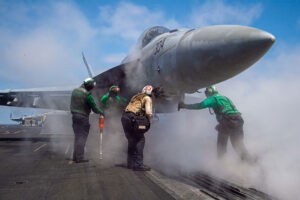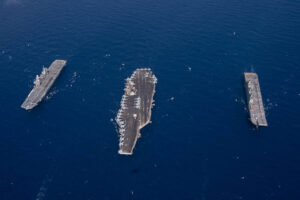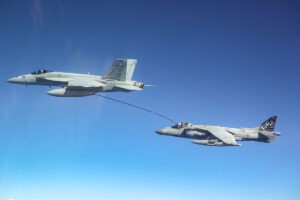After rising from the depths of the Mediterranean Sea at the beginning of the year to demonstrate his fighting power over central and south-eastern Europe for a fortnight, Neptune returned at the end of May for just as long: equipped with a mighty shield, his aim this time was to help his allies protect their territories.
Neptune is of course just an allegory. It stands for NATO's ability to carry out "strikes" from the sea, i.e. to defend itself against threats on land, in the air and/or over water using aircraft, cruise missiles or naval infantry. Within the Alliance, the Naval Striking and Support Forces NATO, or STRIKFORNATO for short, a maritime task force at operational level, is in charge of this special type of naval warfare (see Marine-forum, Vol. 5-2022, pp. 28-31).
Deterrence from sea
With the aforementioned return of Neptune The activity in question was NEPTUNE SHIELD 22abbreviated: NESH22. The idea was to use the "strike" capabilities available in Europe during that period to support various medium- to long-term exercises planned around continental Europe in the short term. Three formations were on standby: one US and one Italian aircraft carrier group and one US amphibious assault group. For the duration of NESH22, they came under the operational control ("OPCON") of STRIKFORNATO. They were commanded from the headquarters in Oeiras near Lisbon, Portugal. Other warships, including the German frigate SACHSEN and a Spanish aircraft carrier battle group, were also involved in the operation. Land-based aircraft and special forces were also involved. In total, around 11,000 soldiers from 25 nations took part directly and indirectly. NESH22 part.
The efforts had two main purposes: firstly, to intensify the process of rapidly placing high-quality naval warfare assets under the control of the alliance. Secondly, they were to be integrated into the land and air dimensions. The goals of NESH22 were therefore to rehearse and show both.

Multinational and multidimensional
Despite the enormous scope and an accompanying social media campaign under the hashtag #NeptuneShield22 NESH22 has hardly been reported on, at least in Germany. There have even been no mentions in the specialised media. This is surprising given that at the beginning of Neptune's first appearance in the spring of this year, there was still a lot of speculation in Germany that the unannounced project, i.e. the new project, would be a success: NEPTUNE STRIKE 22-1 or simply NEST22-1could be a direct response by NATO to the Russian troop deployment along the Ukrainian borders at the time.
One explanation for the lack of reactions to NESH22 may be the intention, structure and sequence of the activity: Under direct orders from NATO's Supreme Commander, SACEUR, and in support of the Allied Joint Force Commands in Brunssum, (Netherlands) and Naples (Italy), STRIKFORNATO coordinated subordinate forces to support Allies during various exercises in dispersed theatres (including "Hedgehog 22" in Estonia, "Mare Aperto 22" around Sardinia and "Alexander the Great 22" in Greece). As a result, and because the battle groups were deployed (i.e. aircraft carriers in the central Mediterranean and amphibious ships in the Baltic and Aegean), there was not one theatre of operations, but several. NESH22 thus lay like a dome over Europe: present everywhere, but not recognisable to everyone at first glance.
Regardless of this, the approach was successful because maritime "strike" effects could be distributed multi-nationally and multi-dimensionally. NATO thus proved that it can skilfully organise its high-value capabilities and simultaneously defend its alliance territory in different places.
Many innovations
NESH22 is available after NEST22-1 the second "vigilance activity" in the long-term NEPTUNE series. STRIKFORNATO has thus repeatedly achieved a series of innovations:
Firstly, the company was able to NEST22-1 planning process, which was already very effective and efficient at the time, was optimised once again. Thanks to the knowledge gained, the planning team was able to increase its efficiency, which led to rapid processing. This enabled STRIKFORNATO to put the finishing touches to the BALTOPS22 exercise, which took place immediately afterwards, at the same time as NESH22.

Secondly, STRIKFORNATO led three battle groups from two nations for the first time. This corresponds to a "NATO expanded task force" (NETF), which can otherwise only be deployed by the USA. For the first time, an Italian unit centred around the aircraft carrier CAVOUR has been placed under NATO command. Its F-35B "Lightning II" could be successfully refuelled by US F/A-18s, which came from the HARRY S. TRUMAN. The same was later achieved with the AV-8B "Harrier II" of the associated Spanish carrier JUAN CARLOS I. Both Mediterranean neighbours were thus enabled to carry out "long-range carrier strikes" with the help of the USA.
Thirdly, it offered NESH22 opportunity to test the "Naval Amphibious Force" of the US Navy and US Marines, which was set up for Europe for the first time in April. The battle group was split up for this purpose: The amphibious assault ship KEARSARGE and the dock landing ship GUNSTON HALL operated in the Baltic Sea together with Marines plus a destroyer, while the dock transport ship ARLINGTON, also with Marines on board, operated in the eastern Mediterranean. The speciality of the unit was not so much its composition, but rather the command and information flow: It was not the Navy that was in command - as was customary until the loading - but the Marines. In addition to foot troops and airmen, they brought with them newly formed reconnaissance forces that can reconnoitre targets both on land and at sea from the coast and forward the data to ships or remote headquarters in a timely manner. This gives superior units a broader picture of the situation on the ground.

First lessons learnt
NEST22-1 already illustrated that naval power in the 21st century is based on two factors: The competence to carry out "strikes" and a high degree of vigilance, i.e. a "cold start capability". What is needed for this was demonstrated in the course of NESH22 refined. Although the NEPTUNE series has not yet been finalised, some principles of success can already be identified. These include, for example, simplicity in planning, interoperability, especially with regard to IT systems, and strategic communication in the sense of rapid reporting with meaningful visual material and clear messages.
In the end, a vigilance activity is about achieving visible results quickly, analysing these and any responses from others and reacting appropriately. The focus is therefore always on the effects to be achieved. NESH22 has proven once again that an alliance such as NATO offers the ideal conditions for this, rather than taking a national or binational approach.
About the authors:
Corvette Captain Helge Adrians serves with STRIKFORNATO, Frigate Captain Dirk Matheis with Joint Forces Command Naples in Italy. The latter is also a liaison officer to the US Naval Forces Europe-Africa and the US 6th Fleet. Both officers were involved in the planning and execution of NEPTUNE SHIELD 22 involved.











One Response
The picture does not show an F-35B, but an AV-8B being refuelled. In addition, the report reads somewhat clumsily due to occasional spelling mistakes. Please proofread such articles, which are certainly valuable in terms of content, before publication.